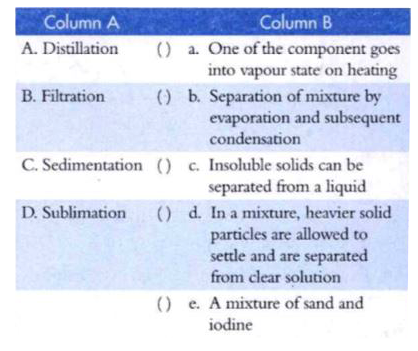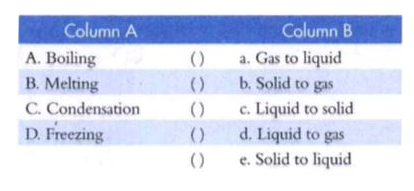Complete Solutions to TEST YOUR CONCEPTS (VERY SHORT ANSWER TYPE QUESTIONS) of chapter CLASSIFICATION OF MATTER of Class 7 book with complete answers and questions
| Class 7 | CHEMISTRY |
| Chapter | CLASSIFICATION OF MATTER |
| PEARSON IIT JEE FOUNDATION | TEST YOUR CONCEPTS (VERY SHORT ANSWER TYPE QUESTIONS) |
| Number Of Questions | 43 |
| Academic Year | 2023-24 |
Generally metals
01:53View SolutionA mixture of chalk powder and ammonium chloride can be separated by
02:22View SolutionIdentify the soft metal among the following
01:47View SolutionWhich among the following is a bad conductor of electricity?
02:06View SolutionThe smallest particle of an element which may or may not have independent existence is called a/an
01:41View SolutionWhich among the following is an element?
01:48View SolutionEvaporation is the process of conversion of
02:05View SolutionThe most convenient way of separating sawdust from water is
01:37View SolutionWhich among the following statements is true?
03:29View SolutionWhich of the following is a heterogeneous mixture?
02:04View SolutionWhich among the following is a heterogeneous mixture ?
03:10View SolutionWhich among the following is a pure substance?
02:10View SolutionIdentify the true statement among the following:
02:44View SolutionProperty exploited in the usage of perfumes
02:05View SolutionBaking soda `(NaHCO_3)` is a compound because
03:05View SolutionWhich among the following pairs possess low melting points ?
02:30View SolutionA form of which of the following non-metal is the hardest substance?
01:59View SolutionPreparation of salt from sea water involves
03:36View SolutionArrange the following in a proper sequence for the separation of constituents of gun powder
(a) Carbon disulphide is added to the mixture
(b) Carbon powder is separated
(c ) Residue is filtered
(d) `KNO_(3)` is separated from its aqueous solution by heating it
(e) Mixture is filtered and hot water is added to the residue02:36View SolutionThe steps involved in the separation of camphor and sand from a mixture are given below. Arrange them in a proper sequence. (1) The wet cloth is placed over the funnel and the stem is closed with a cotton plug. (2) The mixture of camphor and sand is taken in the china dish and an inverted funnel is kept on it. (3) The vapours are cooled and condensed to form the same solid and sand left behind in the dish. (4) The mixture is heated gently where the vapours of camphor is formed.
02:37View SolutionMatch the following columns
 03:35View Solution
03:35View SolutionMatch the following columns
 02:00View Solution
02:00View SolutionMatch the following columns
 02:36View Solution
02:36View SolutionDefine cohesive and adhesive force.
02:48View SolutionDefine melting and boiling points.
02:17View SolutionName the factors which affect the rate of evaporation.
02:55View SolutionDefine atomicity.
01:35View SolutionWhat is the difference between an element and a compound?
03:39View SolutionGive two examples of metals which can exist can exist in liquid state below `35.^(@)C`.
01:40View SolutionWhat is a metalloid ? Give two examples.
01:44View SolutionWhat type of metals are found in free state ?
01:48View SolutionDistinguish sublimate from sublime.
02:29View SolutionWhat is sublimation?
01:13View SolutionWhat is meant by intermolecular space and intermolecular forces of attraction ?
02:46View SolutionMention the factors on which the existence of matter in a particular state depends.
02:30View SolutionDistinguish between melting and boiling.
02:36View Solution"All pure substances are homogenous in nature" Justify.
01:43View SolutionHow can the constituents of compounds and mixtures be separated respectively ?
02:30View SolutionGive two examples for sublimable substances.
01:35View SolutionName any two metals which are poor conductors of electricity
02:23View SolutionMention the difference between filtrate and residue.
02:21View SolutionName two elements which have atomicity more than three .
01:37View SolutionName two states of metter which are fluid.
01:36View Solution
TEST YOUR CONCEPTS (VERY SHORT ANSWER TYPE QUESTIONS) questions and complete solutions for chapter CLASSIFICATION OF MATTER of PEARSON IIT JEE FOUNDATION of Class 7
All Exercises from PEARSON IIT JEE FOUNDATION Class 7 CHEMISTRY CLASSIFICATION OF MATTER
- ASSESSMENT TEST (TEST-1)
- ASSESSMENT TEST (TEST-2)
- CONCEPT APPLICATION (LEVEL -1)
- CONCEPT APPLICATION (LEVEL -2)
- CONCEPT APPLICATION (LEVEL -3)
- EXAMPLE
- TEST YOUR CONCEPTS (ESSAY TYPE QUESTIONS)
- TEST YOUR CONCEPTS (SHORT ANSWER TYPE QUESTIONS)
- TEST YOUR CONCEPTS (VERY SHORT ANSWER TYPE QUESTIONS)
- TEST YOUR CONCEPTS (VERY SHORT ANSWER TYPE QUESTIONS-FILL IN THE BLANKS)
